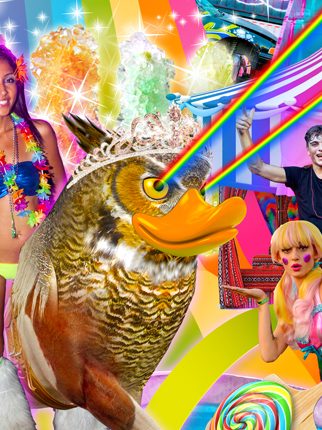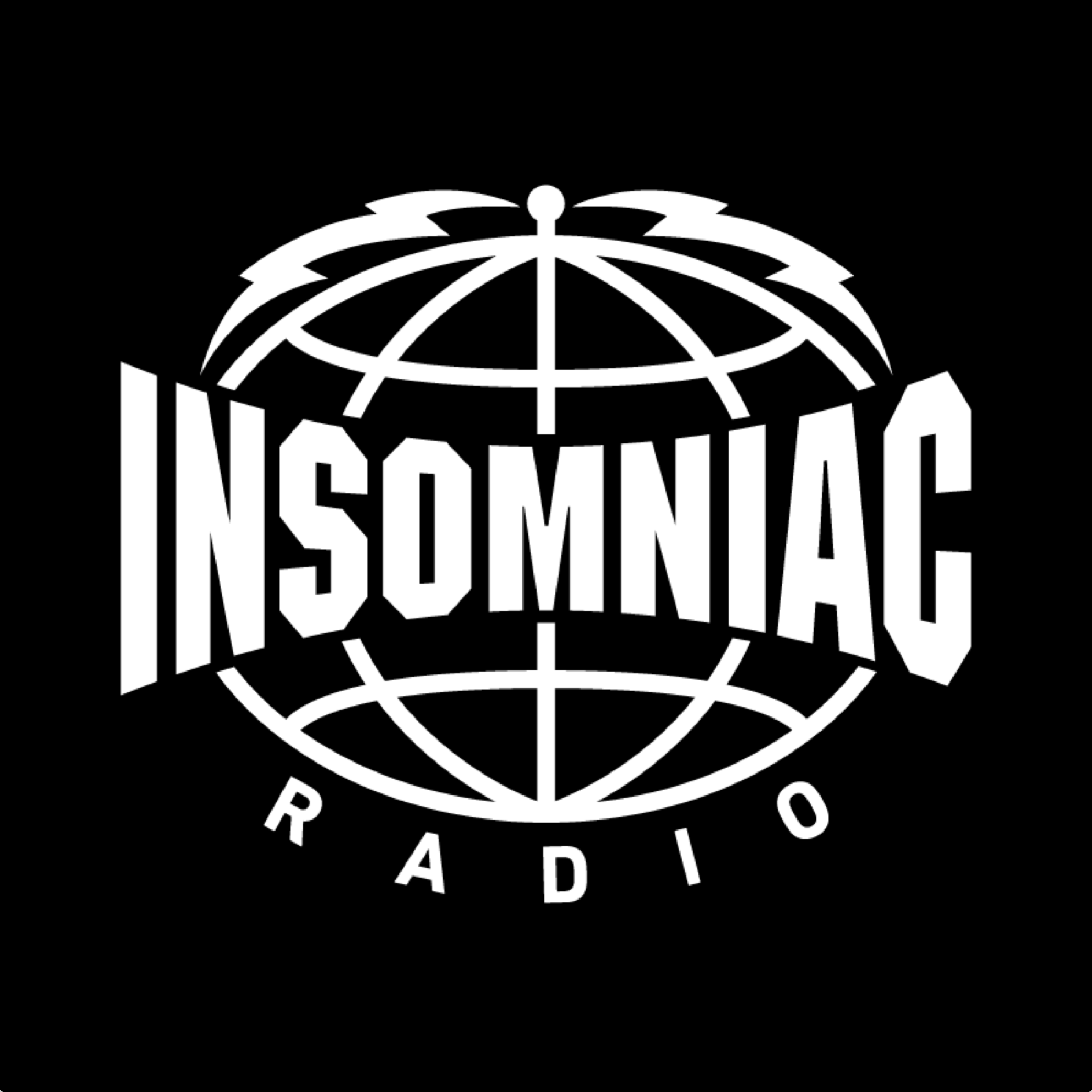Bizarre and Beautiful: The Imaginative Mind of Kenneth Tin-Kin Hung
You may have seen his work in Insomniac’s print magazine at EDC Las Vegas 2015, but for those of you who don’t know him: Meet Kenneth Tin-Kin Hung. For more than a decade, he has made hyper-surreal digital art that mixes everything from ketchup, hot dogs and Big Macs to cross-dressing presidents, despots and dictators to memes, video games and bling. We spoke with Kenneth about his fascinatingly psychedelic work while he enjoyed a glass of wine from the Winey Neighbor, the liquor and wine shop he and his wife run in Brooklyn, NY.
“Those things are what the whole world is about… And that’s kind of what the internet is all about, don’t you think?”
What was it like making art for Insomniac’s 2015 print magazine?
Oh man, it was crazy! I know about the electronic dance scene and Insomniac, since you guys run some of the biggest parties in the world, right? So when you guys contacted me about my old “11111111” website and the idea of working together, I was very surprised. Back in the day, I found out that people were showing it at raves in France, Germany and the US, but I never collaborated with any DJs or anything. So, after you guys contacted me, I started looking into the scene more deeply again and, holy moly, it’s huge! And it’s amazing to see how people can be liberated—temporarily, at least—in a place that everyone can enjoy. I think it’s an amazing thing, so I was very honored when you contacted me.

We were honored to have you! Since we’re on the subject, could you tell me more about your “11111111” website, its beginnings, and its labyrinth-like design?
The “11111111” website was conceived around 10–12 years ago. I was a college student at the time and was really bored with life, plus I worked a job that I really didn’t like. One night, I felt really nihilistic but oddly excited at the same time and had the idea to create, like, the craziest website ever. First, I looked up what the longest website you can have is—64 characters including .com—so I thought, why not shoot for that. [That] led me to the idea of “Sixties One Dot Com,” which, if you say it in out loud, sounds similar to “食屎第一得金,” a Cantonese phrase that translates to, “Whoever can eat the most shit gets the gold.”
Haha! All right, so that’s where the name comes from. That’s awesome.
Yeah, that’s like my personal joke. After I had the domain, I started doing weird stuff in Photoshop and with HTML scripts and putting them up. I was an art student, so I was really just experimenting. Accidentally, though, because of the bizarre name and all the content I put up, it started to get views—like, over 30 million really quickly—and this was when the internet was tiny. So, I just kept working on it and making it branch off and do other stuff because, why not? But that was a long time ago, and I haven’t really updated it for a while.
But your style has remained kind of the same, right?
In a way, yes. They have become more high-def, and I’ve tried to make them hyper-dense with meaning. I want to make images with a lot of eye candy but trapped on one page so, 10 years from now, people can look at them and still see the meaning behind my references.

And where does that hyper-dense idea come from?
I think part of it is because I’ve always been interested in propaganda posters. A lot of old-school Japanese designers like Tadanori Yokoo made some really amazing work in the ‘60s. It might also have to do with growing up in Hong Kong, where we were always bombarded by images that are really packed and dense. During Chinese New Year, for instance, you know the Red Packet? They are always really stuffed and colorful, so maybe some of my aesthetic came from that.
How about the mixture of imagery you present. How and why do you choose them? There are video games, fast food, consumerism in general, emojis, memes, sex, politics—sort of everything we see on a daily basis. Is the idea to put all of these things together?
Exactly! Those things are what the whole world is about. They make up a big social fabric that’s like a huge ecosystem. That’s part of my philosophy. Sex relates to politics, and politics relates to money, and so on. I try to put it all in one frame to represent everything. The second thing that helps me pick images is all about research. Like, when I find out about something regarding a social issue that then inevitably links to other social issues that are connected, but not in the same way. I try to make all of these things interlink.
Finally, how I pick the images is an interesting question, because a majority of the images I get come from Google search or the internet in general. For instance, I don’t want to get political, but if you type in “George W. Bush,” you’ll get a ton of different images. Some of them feature him as a hero like he’s riding an eagle; some, he’s being totally defaced, like a clown, or Pinocchio with the long nose. Those are opposite sides of the same argument, which make them very interesting to me. So, I make Bush Pinocchio riding an eagle, which kind of neutralizes the meaning of both arguments. And that’s kind of what the internet is all about, don’t you think?
Yeah, I see that—everyone gets to speak their mind, so it’s all kind of conglomerated. What was the craziest reaction you’ve had to your work? Do people usually see that neutrality?
They don’t necessarily. But I’ve shown my work at a lot of galleries and museums, and I’ve met all sort of people, like crazy hippies, crazy liberals, old guys, young guys, constitutionalists—you name it—and they all seem to like it, for the most part.
What was your craziest encounter?
For a time, a lot of my work was focused on the Iraq war, and there was one guy who came in… He was like an Army general who had been stationed in Iraq. He walked up to me, looked me in the eye and said, “You know, what you do is really fucked up. I really really hate what you’re doing. But I have to give you credit because it’s neutral in a way; you try to put both sides of an argument together.” And then he shook my hand and just left.
Wow.
Yeah… It was touching. I’ve never been to Iraq, but I did a lot of things against the war and was very passionate about that, and that’s something that I always keep in my mind: that maybe I actually do something good for people, even just by presenting things in a different way.
That’s almost like the ultimate critique! However, I think you are right: There is something in the imaginative way you present things. For instance, there is a quote on some of the deeper pages of your “11111111” website: “Imagination is seizing power; I am seizing imagination.” What does that quote mean for you?
That’s a really old-school punk rock quote. But it definitely has to do with the feeling of my art. Einstein famously said that “imagination is more important than knowledge.” Knowledge, you can acquire, but imagination, you can’t. Knowledge is important, but you have to start with imagination to actually change the world, and that’s why I put it there. We need imagination to change the world.
Check out more of Kenneth’s work here, and let your imagination run wild. For any German readers (or prospective vacationers), check out Kenneth’s work at two shows—focusing on Chinese internet censorship—opening this September at ZKM in Karlsruhe and the German Museum of Technology in Berlin.


